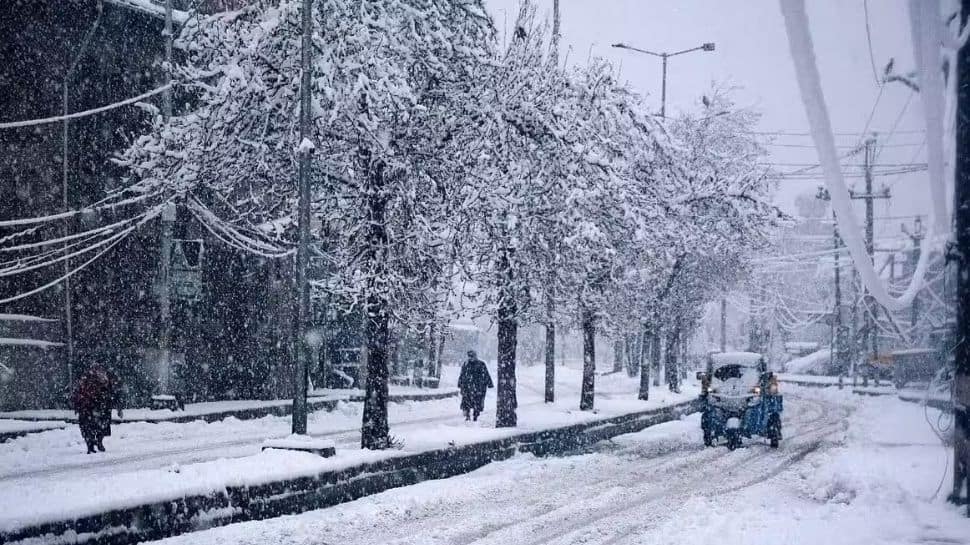 |
|
The recent heavy snowfall in Kashmir has brought the region to a standstill, causing widespread travel disruption and leaving thousands of tourists stranded. The unprecedented snowfall, which began yesterday afternoon and continues in parts of the region, has led to the closure of major highways, suspension of air and rail services, and hours-long traffic jams. The intensity of the snowfall, with 1.5 to 2.5 feet accumulating in southern Kashmir, one foot in central Kashmir, and five to six inches in the north, has overwhelmed the region's infrastructure and left many unprepared for the severity of the conditions.
Tourists arriving in Kashmir were caught completely off guard. Many were unaware of the extreme weather conditions and found themselves trapped in lengthy traffic jams, unable to reach their intended destinations. One particularly harrowing account came from Manju Devi, a tourist from Bareilly, who described being stuck for hours with her children, facing difficulties finding food and worrying about their train reservations. Similarly, a group from Meerut spent hours in traffic, first in Gulmarg and then again on the highway, highlighting the unpredictable nature of the weather and the substantial impact on travel plans.
The impact on transportation has been catastrophic. All major highways, including the Jammu-Kashmir National Highway, Mughal Road, Srinagar-Ladakh Road, and Sinthan-Anantnag Road, have been closed to traffic. Train services on the Banihal-Baramulla track have been suspended, and all flights to and from the region have been cancelled. The scale of the disruption is immense, effectively cutting off Kashmir from the rest of the country. While authorities have deployed approximately 1,200 snow-clearing machines and snow dozers, working to clear approximately 50% of the roads as of the latest reports, the sheer volume of snow presents a significant challenge.
The situation has also highlighted the vulnerability of tourists and the importance of preparedness. Many tourists, after spending hours in the snow, found themselves needing shelter, relying on the kindness of local residents who offered refuge in their homes and mosques. This underscores the critical role of local communities in assisting those stranded and the importance of robust emergency response systems in such situations. The civil administration, police, and locals worked throughout the night to assist stranded tourists, providing shelter and ensuring safety as the snowfall intensified.
The government's response has included establishing control rooms in each district, managed by the District Commissioner. Essential service phone numbers are being broadcast widely via news bulletins and social media. Updates on electricity restoration efforts have been shared via social media by the Chief Minister, illustrating the ongoing efforts to restore basic services. While electricity and water services are gradually being restored, with 80% of electricity and 100% of water restored as of the latest reports, the immediate priority remains clearing roads and ensuring the safety of stranded individuals.
The Meteorological Department's forecast predicts light snowfall in the morning, with conditions expected to improve thereafter. However, the lingering effects of the storm will likely impact travel plans for days to come. The experience has served as a stark reminder of the unpredictable nature of mountain weather and the need for travelers to be properly prepared and to monitor weather forecasts carefully before embarking on journeys in such areas. The sheer number of tourists affected underscores the need for more robust emergency response planning and improved communication channels to assist in future incidents.
Looking ahead, the incident highlights the importance of investing in resilient infrastructure and improved weather forecasting systems. The sheer volume of snow and the speed at which it accumulated clearly exceeded the capacity of current resources. Further investment in snow-clearing equipment and improved road maintenance strategies could mitigate the impact of future snowstorms. Moreover, clear and proactive communication with tourists prior to their arrival, providing up-to-date information on weather conditions and potential travel disruptions, could significantly reduce the risk of future incidents. Effective collaboration between local communities, the civil administration, and emergency services is crucial to ensure swift and effective responses during such emergencies.
The incident also underscores the importance of educating tourists about the risks associated with traveling to high-altitude regions during winter months. While Kashmir's beauty is undeniable, it's equally important to be aware of the potential dangers associated with unpredictable weather. Comprehensive travel advisories, readily available information about emergency services, and readily accessible resources to help those trapped in such situations should all be prioritized. Ultimately, learning from this experience will be crucial in developing strategies to minimize the disruption and ensure the safety and well-being of future visitors to this beautiful but sometimes unpredictable region.
